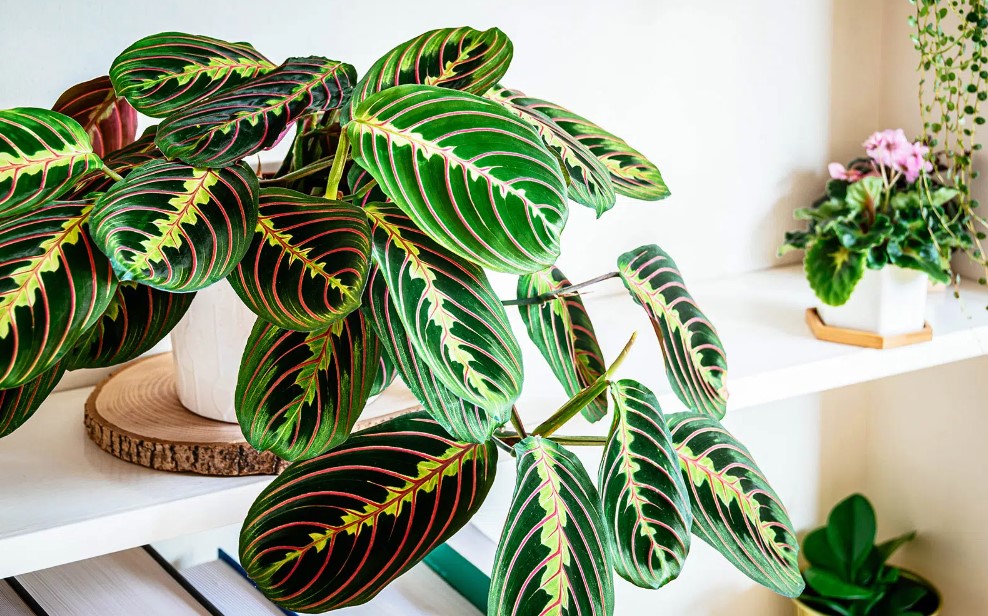Prayer plants (Maranta leuconeura) are beloved houseplants known for their vibrant foliage and unusual movement. These tropical beauties are sought after not only for their stunning leaves but also for their occasional flowering displays. This article will explore the fascinating process of prayer plant flowering, including the conditions required for blooms, the different types of flowers, and how to care for your prayer plant during the flowering period. So, let’s delve into the blooming world of prayer-plants!
Understanding Prayer Plant Flowering
What triggers prayer plant flowering? Prayer plants bloom in response to specific environmental cues. While each plant may have its preferences, factors contributing to flowering include proper lighting, humidity levels, temperature, and maturity. Consistency in these conditions helps initiate the flowering process.
Photoperiodism, the plant’s response to light duration, is crucial in prayer plant flowering. These plants must balance light and darkness to set their internal clocks. Generally, a 12- to 14-hour photoperiod of bright, indirect light followed by 10 to 12 hours of the night helps promote flowering.

Types of Prayer Plant Flowers
- Inflorescence structure
Prayer plant flowers emerge from long, slender stalks called inflorescences. These structures bear the actual flowers and can vary in appearance, depending on the species or cultivar.
- Flower characteristics
Prayer plant flowers typically possess striking features such as vibrant colors and intricate patterns. The petals often showcase shades of white, yellow, purple, or red, while the intricate designs may include spots, stripes, or complex lines.
Caring for Prayer Plants During Flowering
- Light requirements: During the flowering phase, prayer plants benefit from bright, indirect light. Avoid exposing them to direct sunlight, as it may scorch the delicate flowers and foliage. Place your plant near a window with filtered light, or use sheer curtains to diffuse direct sunlight.
- Maintaining humidity: Prayer plants thrive in humid environments, which mimic their natural tropical habitat. To increase humidity levels, consider using a humidifier, placing a water-filled tray near the plant, or misting the leaves regularly. Higher humidity helps keep the flowers and foliage healthy and prevents them from drying out.
- Temperature considerations: Maintain a consistent temperature range of around 65-75°F (18-24°C) during the day and slightly cooler temperatures at night. Fluctuations outside of this range may affect flower formation and overall plant health.
- Adequate watering: Water your prayer plant thoroughly, allowing the top inch of soil to dry out between waterings. Ensure proper drainage to prevent waterlogged soil, which can lead to root rot. Aim for a balance between moisture and avoiding overwatering to promote healthy blooms.
- Fertilization: During the flowering period, provide your prayer plant with a balanced, water-soluble fertilizer once a month. Follow the package instructions for proper dilution and application. Avoid over-fertilization, as it can cause fertilizer burn and damage the plant.
Pruning and Maintenance
To maintain a healthy and flourishing prayer plant, regular maintenance is essential. Remove faded or wilted flowers promptly to redirect the plant’s energy toward new flower production. Prune any damaged or yellowing leaves to keep the plant visually appealing and prevent the spread of diseases.

Conclusion
Prayer plant flowering is a delightful event showcasing these stunning houseplants’ hidden beauty. By providing the right conditions, such as appropriate lighting, humidity, temperature, and proper care, you can encourage your prayer plant to bloom and adorn your living space with beautiful flowers. Remember to be patient, as flowering may vary among individual plants. With consistent care and attention, your prayer plant will reward you with vibrant blooms, enhancing the aesthetic appeal of your indoor garden. Happy gardening, and enjoy the magical journey of prayer plant flowering! Read article about Philodendron Aquarium and Chinese Money Plant Drooping in Avi Hoffman Garden.
FAQ
Prayer plants typically flower in response to specific environmental cues. When the plant is provided with optimal conditions, such as appropriate lighting, humidity levels, and temperature, it triggers the flowering process. The plant’s maturity also plays a role, as more established plants are more likely to produce flowers. If your prayer plant is flowering, it indicates it is receiving the right conditions and is healthy.
When your prayer plant starts to flower, providing it with the care it needs to maintain its blooms and overall health is crucial. Here are a few key steps to follow:
Ensure proper lighting: Place your plant in bright, indirect light. Avoid direct sunlight, as it can scorch the delicate flowers and foliage.
Maintain humidity: Prayer plants thrive in humid environments. Increase humidity by using a humidifier, placing a water-filled tray near the plant, or misting the leaves regularly.
Maintain consistent temperature: Keep the temperature within a range of around 65-75°F (18-24°C) during the day and slightly cooler at night.
Water properly: Water your plant thoroughly, allowing the top inch of soil to dry out between waterings. Avoid overwatering to prevent root rot.
Fertilize: Apply a balanced, water-soluble fertilizer once a month during flowering. Follow the package instructions for proper dilution and application.
By providing these necessary care measures, you can help your prayer plant thrive and extend the lifespan of its flowers.
A happy prayer plant displays several signs indicating its well-being. Here are a few indicators of a content prayer plant:
Vibrant foliage: The leaves of a healthy prayer plant will be lush, dynamic, and free from discoloration or wilting.
Balanced growth: The plant will exhibit balanced growth, with new leaves emerging regularly and old leaves remaining healthy.
Regular flowering: If your prayer plant produces flowers, it indicates that it is in a favorable environment and thriving.
Active movement: Prayer plants have a unique feature where their leaves fold up at night, resembling hands in prayer. If you notice this daily movement, it is a positive sign that your plant is healthy.
While prayer plants require adequate light to thrive, they do not tolerate direct sunlight. Too much sun exposure can lead to leaf burn and damage to the plant. It is best to provide your prayer plant with bright, indirect light. Place it near a window with filtered light or use sheer curtains to diffuse direct sunlight; this will ensure that your prayer plant receives the right amount of light without being subjected to harsh rays that can harm its foliage.







